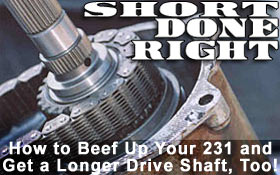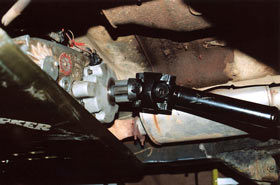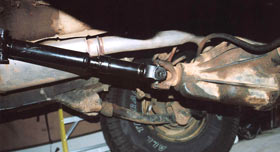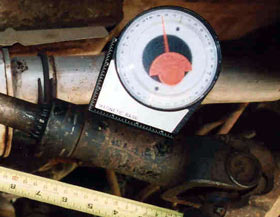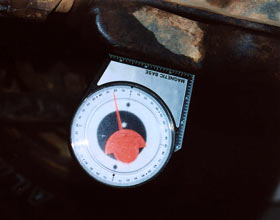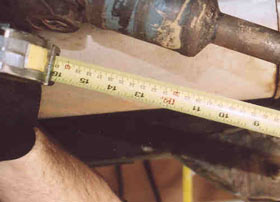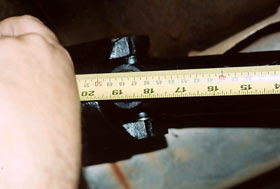|
|
|||||
| Driveshaft Arrival & My Mistake: I will say that the shaft we got was nicely done, with all Spicer components and it appears to be a quality unit. It was painted a high-gloss black (including the bearing caps which I don't prefer but many shops do them that way) and the welds were clean and even. I couldn't ask for more then that. Of course, I will abuse it over the next few months and see how well it holds up and post an update in the forums at that time. I did notice that the extra length changed the overall driveline angle from approximately 26 degrees to around 23 degrees, which means it will also reduce the u-joints' working angle by 3 degrees and hopefully save me from changing them anytime soon.
After installing the new shaft and making sure that everything fit as expected, I took a few measurements and drove the thing around the block . Everything felt good so I was happy to say that the hardest part of this installation was done. The next morning I had to drive the Jeep about 70 miles to a benefit and truck show my local club was putting on, and a good portion of those were on the highway. The first thing I noticed was that with my 35" Pro-Comp All-Terrains (my street tires) the speedometer was about 3 mph fast at 60 mph (based on readings from my Garmin GPS-V. The second thing I noticed was that I never should have put that Polyurethane Transmission Mount in place of the stock one - but that is a whole other story. I had no driveline vibration and the electronic feed to the stock speedometer seemed to work fine - even the cruise control had no issues. I thought it was fine, anyway - right up until Monday when I drove it to work. On Monday, about halfway to work, the speedometer started acting really funny. Under acceleration, the speedometer would climb like normal but once I pulled my foot off the gas the speedometer would drop 10 to 30 MPH below the speed that the vehicle was actually traveling. Sometimes it worked and sometimes it was jumping all over the place. When I got home on Monday night I crawled under the Jeep to make sure all the connections were good and tight and that I had not missed anything during the install. I drove it around the block and it was still doing it. A lot of things went through my mind, but I figured I better just call JB and see if they had encountered this before. When I called JB, I spoke to John White and, yep, they had seen this before. The solution was easy...follow the directions! No, he didn't actually tell me that but what he did tell me was that they have seen this issue when the installation was not done in shop and the proper methods of ensuring the nut was properly torqued were not used. The problem? The rear output nut is manufactured and designed to be torqued down to 180 ft lbs and it simply was not torqued down properly, which allowed the tone ring to spin independently of the output shaft.
This is where I referred back in the installation portion. It is my recommendation that you install the transfer case back into the vehicle and then torque the front and rear nuts down. It proved to be much easier to do this time - except that I had to remove both driveshafts (one at a time so that the other one would keep the transfer case from turning). I easily torqued both transfer case output shafts to the proper ft lbs (130 for the front and 180 for the rear) and reinstalled the drive shafts. After testing it and driving it for a few more days, this ultimately solved the problem of the funny readings on the speedometer. However, the speedometer MPH was off and would probably be even worse with my 36.5" tall off-road tires, so it was time to install and calibrate the Dakota Digital SGI5. |
|||||
|
Help spread the ROCKCRAWLER world!
Share on Facebook
|
